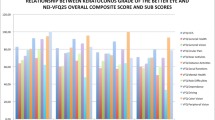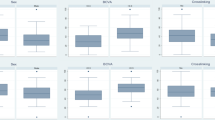Abstract
To assess the visual function of patients with keratoconus who underwent penetrating keratoplasty with the use of the VF-14 questionnaire. Fourteen patients (9 male and 5 female) with a mean age of 38 years (SD 13.59) participated in the study. All patients had keratoconus, confirmed by corneal topography, and all had previously undergone penetrating keratoplasty in one eye. Their mean best-corrected visual acuity (BCVA) binocularly was 0.185 (SD 0.077) LogMAR. None of the grafted eyes had a BCVA <0.300 LogMAR. Fourteen healthy volunteers, age- and sex-matched, also participated in the study as control subjects. The VF-14 questionnaire was used to evaluate the effect of the ocular status in the daily life activities of the patients. The mean VF-14 result for the grafted patients with keratoconus was 62.37% (SD 22.60) and for the control group it was 100% (P < 0.001). There was only a weak correlation between the VF-14 score and the binocular BCVA (r = −0.394, P = 0.163). The mean VF-14 result in grafted patients with keratoconus is indicative of low functional ability despite the satisfactory postoperative BCVA. The absence of a significant correlation between the VF-14 score and the mean BCVA indicates that the low functional visual ability in these patients is probably associated more with the ‘perceived by themselves’ difficulty due to their ophthalmological condition.


Similar content being viewed by others
References
Rubin GS, Adamsons IA, Stark WJ (1993) Comparison of acuity, contrast sensitivity, and disability glare before and after cataract surgery. Arch Ophthalmol 111:56–61
Bodis-Wollner I (1980) Detection of visual defects using the contrast sensitivity function. Int Ophthalmol Clin 20:135–153
Elliot DB, Hurst MA, Weatherill J (1990) Comparing clinical tests of visual function in cataract with the patient’s perceived visual disability. Eye 4:712–717
Mannis MJ, Zadnik K, Johnson CA (1984) The effect of penetrating keratoplasty on contrast sensitivity in keratoconus. Arch Ophthalmol 102:1513–1516
Bernth-Petersen P (1981) Visual functioning in cataract patients: methods of measuring and results. Acta Ophthalmol 59:198–205
Hess RF, Carney LG (1979) Vision through an abnormal cornea: a pilot study of the relationship between visual loss from corneal distortion, corneal edema, keratoconus, and some allied pathology. Invest Ophthalmol Vis Sci 18:476–483
Mannis MJ, Zadnik K, Johnson CA et al (1987) Contrast sensitivity after penetrating keratoplasty. Arch Ophthalmol 105:1220–1223
Koenig SB, McDermott ML, Hyndiuk RA (1989) Penetrating keratoplasty and intraocular lens exchange for pseudophakic bullous keratopathy associated with a closed-loop anterior chamber intraocular lens. Am J Ophthalmol 108:43–48
Mangione CM, Phillips RS, Seddon JM, Lawrence MG, Cook EF, Dailey R et al (1992) Development of the ‘activities of daily vision scale’. A measure of visual functional status. Med Care 30:1111–1126
Brémond-Gignac D, Tixier J, Missotten T, Laroche L, Beresniak A (1999) Evaluation of the quality of life in ophthalmology. Trans Am Ophthalmol Soc 97:473–511
Fujita A, Hieda O, Nakajima N, Kinoshita S (2005) The VF-14 index of functional visual impairment in patients with corneal disease treated by phototherapeutic keratectomy. Nippon Ganka Gakkai Zasshi 109:736–740
Musch DC, Farjo AA, Meyer RF, Waldo MN, Janz NK (1997) Assessment of health-related quality of life after corneal transplantation. Am J Ophthalmol 124:1–8
Boisjoly H, Gresset J, Charest M, Fontaine N, Brunette I, Lefranc M et al (2002) The VF-14 index of visual function in recipients of a corneal graft: a 2-year follow-up study. Am J Ophthalmol 134:166–171
Brahma A, Ennis F, Harper R, Ridgway A, Tullo A (2000) Visual function after penetrating keratoplasty for keratoconus: a prospective longitudinal evaluation. Br J Ophthalmol 84:60–66
Scott IU, Smiddy WE, Schiffman J, Feuer WJ, Pappas CJ (1999) Quality of life of low-vision patients and the impact of low-vision services. Am J Ophthalmol 128:54–62
Author information
Authors and Affiliations
Corresponding author
Rights and permissions
About this article
Cite this article
Ziakas, N., Kanonidou, E., Mikropoulos, D. et al. The impact of penetrating keratoplasty in patients with keratoconus using the VF-14 questionnaire. Int Ophthalmol 31, 89–92 (2011). https://doi.org/10.1007/s10792-010-9414-8
Received:
Accepted:
Published:
Issue Date:
DOI: https://doi.org/10.1007/s10792-010-9414-8




